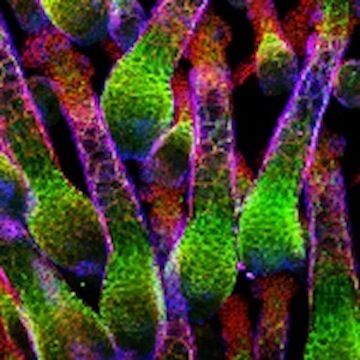What's This Winning Science Image?

A riot of colorful squiggles is the winning image in a contest held to celebrate the birthday of a genetics journal. So, what is this cacophony of colors?
The image is of mouse skin.
The image comes from a paper published in the open-access journal PLOS Genetics in October 2014. It won a reader survey to represent the journal online and on Twitter during its 10th anniversary this month. [Magnificent Microphotography: 50 Tiny Wonders]
But how can plain mouse skin look so kaleidoscopic? The researchers stained the skin (from mice tails) with fluorescent compounds that cling to certain proteins. This image shows three of those proteins: claudin-1 in green, keratin 14 in blue and E-cadherin in red.
The goal of this pretty microphotography was to discover new genes that keep the skin functioning normally, according to a blog post by the paper's authors. The researchers used genetically engineered mice to inactivate more than 500 genes, one at a time, to see what each gene did.
They found a particularly influential gene — keratin 76, which provides the blueprint for multiple skin proteins. Without this gene, the "tight junctions" that link skin cells together were defective, the researchers found. Most notably, the claudin-1 proteins were all out of place. (The winning image shows claudin-1 in its normal position.)
Without keratin 76, the skin's waterproof barrier was also damaged, the researchers found, and wounds weren't able to heal normally. This suggests that keratin proteins (which famously make up hair and fingernails) aren't just structural scaffolds, as had been thought; rather, they take a much more active role in the skin, the researchers wrote.
Sign up for the Live Science daily newsletter now
Get the world’s most fascinating discoveries delivered straight to your inbox.
The winning image beat out four other impressive images to take top place in the 10th-anniversary contest. The other images were a shot of the early development of the inner ear; an orange-and-yellow photograph of a thumbprint; a ceramic blue image of a yeast colony; and an image of gene expression in the genital tract of a fruit fly.
Follow Stephanie Pappas on Twitter and Google+. Follow us @livescience, Facebook & Google+. Original article on Live Science.

Stephanie Pappas is a contributing writer for Live Science, covering topics ranging from geoscience to archaeology to the human brain and behavior. She was previously a senior writer for Live Science but is now a freelancer based in Denver, Colorado, and regularly contributes to Scientific American and The Monitor, the monthly magazine of the American Psychological Association. Stephanie received a bachelor's degree in psychology from the University of South Carolina and a graduate certificate in science communication from the University of California, Santa Cruz.











